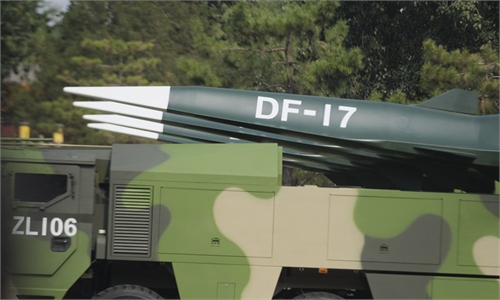China’s counter-deterrence best response to US threats from 2nd island chain: Global Times editorial

A formation of Dongfeng-41 intercontinental strategic nuclear missiles takes part in a military parade celebrating the 70th anniversary of the founding of the People's Republic of China in Beijing, capital of China, October 1, 2019. Photo: Xinhua
The US Department of Defense released on Tuesday an unclassified version of the 2021 Global Posture Review (GPR). The report plans to improve airfields in Guam and Australia to "counter China's military buildup and more assertive use of power," according to a report by The Wall Street Journal, which also confirmed that the GPR "contains no major reshuffling of forces."The GPR highlights the Indo-Pacific region as a priority area for the US military, and improving airfield construction in Guam and Australia, including adding more facilities to store fuel and ammunition, could provide reinforcements of warplanes and military personnel in a short time. The US is building a deterrent against China.
It is worth mentioning that the unclassified part of the GPR focuses on Guam and Australia - both are strategic points in the second island chain. In the past two years, the US has mentioned less about the construction of strongpoints in the first island chain. This is not only because the first island chain is already well built but also because there is speculation that the US no longer counts on the first island chain.
If there is a military conflict between China and the US, it will most likely take place in the Taiwan Straits or the South China Sea. The strengthening of US strongpoints in the second island chain shows how big the potential range of such a military conflict would be.
If a war breaks out between China and the US, it is unlikely to end with a few warships of both countries fighting each other at sea. US preparations now have already included the capacity of military mobilization outside the region, so China's military preparedness now needs to include a response to them.
China needs to build a credible conventional capability to strike those strategic points in the second island chain of the US. We can keep a low profile when we do it, but the information should be gotten across to the US and its allies. Those strategic points should know that the moment they are involved in supporting US deterrence against China, they will become targets of China's counter-deterrence. If they ever become the fulcrum of US attacks on Chinese People's Liberation Army (PLA) around China, they will become part of an expanded battlefield.
US allies in the Asia-Pacific region, such as Australia, are taking the initiative to strengthen their ties with the US. They have also shown an eagerness to support US forces in their operations against the PLA some day in the future. They feel that strengthening their alliance with the US will only increase their influence as a bargaining chip. We should make them aware that by doing so, they actually face more risks. As the saying goes, "No pain, no gain."
The US has many allies and many overseas military bases, so its military buildup against China can be all-around. Meanwhile, China faces many obstacles to establishing new military positions. Such a situation can hardly be changed in a short period of time. Therefore, China must have a strong capability to make the US military positions within the second island chain harmless in times of war to achieve a balance between China and the US. In other words, to make them harmless, we should either deter those strongpoints from going against China, or destroy them in one fell swoop.
Australia is eager to follow the US. This is typical of Canberra. It is also extremely reckless and almost arrogant in terms of strategy. China needs to make it clear to Australia through capacity buildup and leaks of information: If Australia is ready to follow the US and get involved in a war in the Taiwan Straits, as well as to use US bases in Australia as a springboard for their involvement in the war, then it is putting its own national security at stake.
As China lacks overseas military bases, it is vital to greatly develop and stockpile a significant number of missiles that can strike targets in the second island chain. Those missiles are not costly and can strike from a distance, so they are quite cost-effective. It can be said that in whatever positions the US and its allies are preparing for attacks against China, our missiles should be ready to target those points.
China could aptly increase its transparency in this area. This way, the US and its allies can say nothing about it, while our deterrence will be strengthened. In fact, the conventional use of the military is to deter potential enemies. As an old Chinese saying goes, "Military forces are to be used only for preventing conflicts and maintaining peace."

